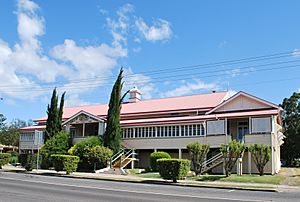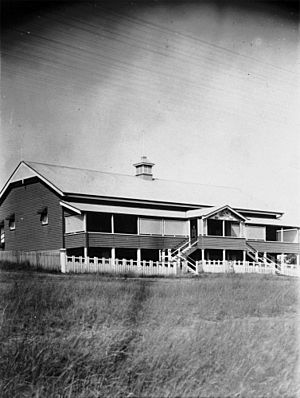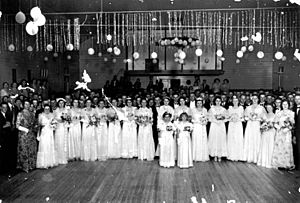Goomeri Hall of Memory facts for kids
Quick facts for kids Goomeri Hall of Memory |
|
|---|---|

Goomeri Hall of Memory, 2010
|
|
| Location | Boonara Street, Goomeri, Gympie Region, Queensland, Australia |
| Design period | 1919 – 1930s (interwar period) |
| Built | 1926 |
| Architect | Philip Oliver Ellard Hawkes |
| Official name: Goomeri Hall of Memory | |
| Type | state heritage (built) |
| Designated | 21 October 1992 |
| Reference no. | 600641 |
| Significant period | 1926– (social) 1926–1971 (historical) 1926–1951 (fabric) |
| Significant components | roof/ridge ventilator/s / fleche/s, memorial – hall |
| Lua error in Module:Location_map at line 420: attempt to index field 'wikibase' (a nil value). | |
The Goomeri Hall of Memory is a special building in Goomeri, Queensland, Australia. It was built in 1926 to remember the brave people from the area who served in World War I. Over time, it has also come to honour those who served in other wars. This important hall was designed by Philip Oliver Ellard Hawkes. Today, it is listed on the Queensland Heritage Register, which means it's protected because of its historical value.
Contents
History of Goomeri's Memorial Hall
The Goomeri Hall of Memory first opened its doors in 1926. It was created to honour everyone from the Goomeri district who served in World War I. Later, its dedication was expanded to include those who served in all wars.
Early Days in Goomeri
European settlers first arrived in the Goomeri area between 1843 and 1850. They set up large farms for raising animals. By 1870, these big farms were divided into smaller ones. In 1902, the Nanango railway line reached Goomeri, helping farmers and timber workers. In 1911, land was sold for shops and homes, and more farms were started. A butter factory was also built. By the 1930s, Goomeri grew into a busy rural town with a school, showground, and churches.
Remembering World War I Heroes
World War I (1914–1918) deeply affected Australia, even though the fighting was far away. Australia, being a British colony, quickly joined the war to support Britain. More than 300,000 Australians volunteered, and about 60,000 of them died. Almost every community, including Goomeri, lost young men.
After the war, most towns wanted to build memorials for those who served. In Goomeri, a memorial was first placed in Digger Perrett Park. Later, the Goomeri War Memorial Clock replaced it in 1940. The local branch of the RSL (a group for ex-service people) was formed in 1926. Its members were key in getting the Hall of Memory built.
A public meeting in March 1926 led to the creation of a building committee. This committee was tasked with finding land and a building for a community hall. At the time, memorial halls were not common. Most war memorials were statues or monuments. The Goomeri Hall of Memory is one of the few early buildings dedicated as a war memorial.
Building and Early Uses
The building committee bought an existing timber store from Nanango. It was then moved and set up in Goomeri by May 1926. A special floor was laid for dancing, and the hall was painted.
At first, a man named Mr. A. Rich leased the hall to show silent movies. His wife had a sweet shop under the hall. To pay off the building's debt and buy furniture, many events were held from 1927. These included concerts, dances, sports days, and even a "popular girl" competition. By Easter 1929, all debts were cleared.
In 1931, a large supper room with a kitchen was added. This room was used for meetings and smaller events. In 1935, parts of the walls between the hall and the enclosed verandahs were removed to make more space.
Mr. A. Duffy later leased the hall for showing films for a long time. He also looked after the building. He installed electricity and equipment to show "talkies" (movies with sound). In the 1940s, he was one of the first in the country to install CinemaScope, a wide-screen movie format.
World War II and Beyond
During World War II, the basement of the hall was used to store emergency supplies in case of a Japanese invasion. After the war, these supplies were removed. The basement area was then divided into clubrooms for the RSL. The Citizen's Military Forces also used this space for drills and the hall grounds for parades.
In 1950, memorials for World War II were ordered. These were bronze plaques with photos of those honoured. They were officially revealed on ANZAC Day in 1951.
In the 1950s, fewer people came to watch films. Movies were eventually stopped in the late 1950s, but the hall continued to be used for many other events. In 1971, the local council took over responsibility for the hall. After this, the kitchens were updated, and a bar was added. The RSL's kitchen was also modernised in 1991. The hall is still used regularly for many social events and activities today.
What the Hall Looks Like
The Hall of Memory is a tall timber building with a corrugated iron roof. It stands out on Boonara Street, at the corner of McGregor Street in Goomeri. It is surrounded by well-kept gardens. The building has a main rectangular hall with a gabled roof. There's also a smaller gabled section attached to one end. At the back, toilet blocks are connected, and the area underneath the hall has been built in to create a basement.
Outside Features
The main hall is long and faces the street. Along this side, there is an enclosed verandah and a central gabled porch entry with stairs. On the porch gable, you can see the Commonwealth coat of arms with the words "Hall of Memory 1914 – 1918" above it. A decorative timber vent sits on top of the main roof. The smaller building attached to the side also has its own roof, a front verandah, and a separate stair entrance.
Inside the Hall
The main hall's walls are covered with beaded timber boards, and it has a timber ceiling and floor. One end has a stage with a curved front and space for a piano. At the back of the room, there is a modern bar with a projection box above it. The stairs to the projection box were removed to make space for a steel cold room. Behind the bar is a large supper room that leads into the kitchens. There is an old kitchen stove in a smaller room, but a modern stove and cabinets are in the larger kitchen area.
Inside the main hall, you will find several memorials. These include:
- A modern timber roll of honour for Goomeri and the surrounding district.
- Timber-framed metal honour rolls for World War I.
- 21 individual memorials, which are decorative bronze plaques with a photo of the person being honoured. Nine of these are for World War I, and twelve are for World War II.
- A special memorial for people who helped fund the hall. It looks like an open metal book on a marble plaque.
The verandah at the front of the hall has been enclosed with casement windows that have obscure and green glass. There are large openings from the hall into these areas, creating two long rooms. The central porch has a ticket booth, which can be accessed from inside the hall, and is flanked by pairs of entry doors leading into the main hall.
The basement area has been built in and has tall, narrow windows. The toilet block on the corner is made of fibrous cement planks on a concrete block base, with a sloped roof and sliding aluminium windows.
Why the Hall is Heritage Listed
The Goomeri Hall of Memory was added to the Queensland Heritage Register on 21 October 1992. This means it's considered very important for several reasons:
Showing Queensland's History
The Goomeri Hall of Memory helps us understand how Queensland's history developed. It's a memorial to the people from Goomeri who served and died in World War I and later wars. Building this hall also shows the strong patriotic feelings people had after World War I. It highlights how communities felt connected to the British Empire at that time.
A Rare Type of Memorial
This hall is special because it's a relatively rare type of World War I memorial in Queensland. Most memorials were monuments or statues. The Goomeri Hall is unique because it's a building used for both remembering the fallen and for community activities.
A Great Example of its Kind
The Goomeri Hall of Memory is a good example of a building designed for returned soldiers and their families. It has honour rolls, meeting rooms, a supper room, and a dance hall. The main hall itself is a great example of a large community hall, with its special timber dance floor, a stage, and many windows.
Beautiful and Important to the Town
The Hall of Memory is a large, well-designed building on a high, noticeable spot. It adds a lot to the look and feel of Goomeri town. Its beauty and prominent location make it a landmark.
Strong Community Connection
The Goomeri Hall of Memory has a very strong connection with the Returned Services League (RSL) as both a war memorial and a place for meetings. It also has a special link with the entire Goomeri community. This is because it has been used for so many social events over the years, including dances, concerts, and movie showings.



